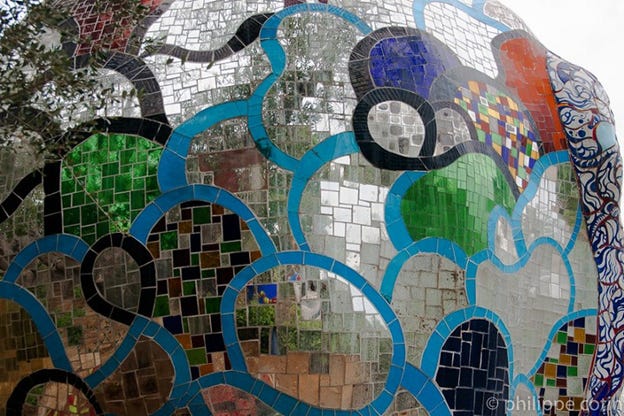
Without a doubt, the most frequently asked question about Tarot is:
“Does it work?”
And the most truthful answer is “Yes.”
But Tarot can be many things — so “works” will have different meanings for different people. That’s one reason this unique collection of images and ideas has remained fascinating for centuries, and continues to generate creative energy today.
If you’d like a quick introduction/refresher on Tarot, I’ve provided for that. But right now I want to paint a bigger picture.
Imagine a walled garden, with ten doors. If you enter by one door, you will gain a particular perspective on the garden — and if you enter by another, a different perspective.
From each door runs a distinctive path. Though the paths start in separate places, they cross and converge at many points. Sometimes predictably, sometimes quite unexpectedly.
Each of these ten doors will open to a particular view of the Tarot, and lead to a particular path . . . .
The symbolism door | From this vantage, you will see Tarot as an organized set of aesthetic/cultural elements (tropes or archetypes), represented primarily by pictures. | Along the symbolism path, you can expect to find works of literature, worlds of myth, and scholarship drawn from the fields of psychology, anthropology, and cultural history.
The esoteric door | From this vantage, you will see Tarot as a visual document that encodes hidden philosophical constructs. | Along the esoteric path, you may find Tarot in connection with secret societies (such as the Rosicrucians and Golden Dawn), as well as a long history of hermetic literatures and occult traditions.
The aesthetic door. From this vantage, you will see Tarot as a predefined set of images and ideas that can inspire or structure works of visual art. | Along the aesthetic path, you may expect to discover centuries’ worth of art history, thousands of Tarot images created by hundreds of modern artists, and many conceptual works inspired by the Tarot.
The history door. From this vantage, you will see Tarot as a material artifact that reflects various cultural contexts over time. | Along the history path, you could encounter interests that range from the origin of playing cards to the evolution of printing and the development of secret societies.
The magick door. From this vantage, you will see Tarot as a toolset for invoking divinities, obtaining desired outcomes, or transforming consciousness through ritual practices or experimental methodologies. | Along the magick path, you can expect to see shamanic traditions, alchemical explorations, qabalistic pathworking, Wiccan spellcasting, and more.
The divination door. From this vantage, you will see Tarot as a device for use in obtaining knowledge of unknown past/present influences as well as future events or trends. | Along the divination path, you find Tarot in company with many other oracle systems, from the I Ching to astrology.
The therapeutic door. From this vantage, you will see Tarot as a means of evoking memories, associations, emotions, or other kinds of experience that aid in self-discovery and personal healing. | Along the therapeutic path, you might find projective instruments like the Rorschach and Thematic Apperception tests, along with hypnosis, journaling, and bodywork.
The meditation door. From this vantage, you will see Tarot as a tool for use in mindfulness practice, inner work, and spiritual growth. | Along the meditation path, you might find Tarot in company with technologies such as certain yogas, zazen, and tai chi, as well as methodologies like centering prayer and guided meditation.”
The creativity door. From this vantage, you will see Tarot as an imaginative environment that inspires or enhances thinking, writing, playing, and making. | Along the creativity path, you may find Tarot reflected or enacted in theater, music, craft, poetry, cooking, storytelling, invention, and much more.
The social door. From this vantage, you will see Tarot as an active interest that fosters interpersonal connections and provides a sense of community. | Along the social path, you can expect to find a variety of gatherings and opportunities for interpersonal connection, from workshops to Facebook groups. You can also find Tarot-themed marketing and even disinformation on social media.
Some people enter the world of Tarot through a particular door and stay very near it forever. In fact they may insist that their own way of seeing Tarot is the only “true” path. But other people roam far and wide, exploring connections that link the various paths.
My sketch of the ten doors is meant as a map of possibilities, to be used either for picking a point of departure or charting an expanded route.
If you’ve never explored the Tarot, pick the door that interests you most, and focus for a while before branching out. If you’re far along one path already, you might want to pick the path that seems most opposite, and see where the two converge. Those are the doors as I see them — and wherever you enter, or wherever you go next, I hope you have a grand journey.
If you want to take a book along with you on any chosen path—I’ve made some suggestions. And if you are new to Tarot, or would like a general refresher, check out An Introduction to Tarot.




What a beautiful & innovative description of the tarot!
Great description using the doors. Perfect way of illustrating tarot to people.